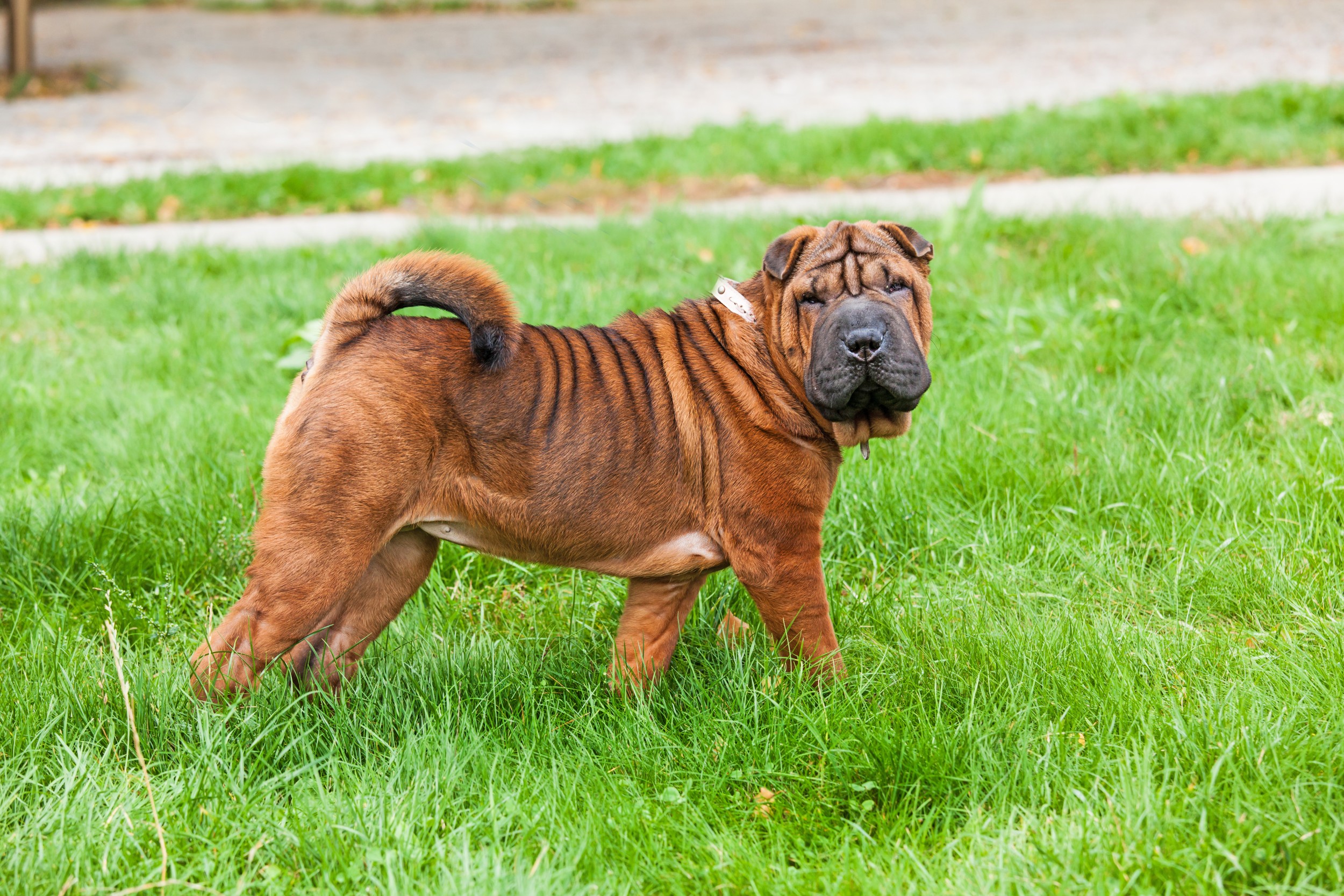
Chinese SharPei [Ultimate Guide Health, Personality & More]
Shar Pei Fever Treatment depends on the severity of the symptoms and the health of the dog. The main objectives of treatment are symptom management and inflammation reduction. Commonly used therapies include: Anti-inflammatory medications: Non-steroidal anti-inflammatory drugs (NSAIDs) can help to minimize joint pain and swelling, as well as.

sharpei keverék kutya 202112202 Bogáncs Kutya és Kisállatotthon Alapítvány
Also called swollen hock syndrome, Shar-Pei auto-inflammatory disease (SPAID), or familial Shar-Pei fever syndrome (FSF). It would seem the Chinese Shar-Pei might have enough issues to contend with, given its potential for wrinkle-related skin and eyelid issues, but there is a special syndrome that every Shar-Pei owner needs to be familiar with: Recurrent Fever Syndrome.

5 Things to Know About the SharPei Petful
Shar-Pei Fever: This breed-specific condition causes the dog to develop a high fever, swelling of the hock joint, become lethargic, and experience bouts of vomiting and/or diarrhea. Gastric Torsion/Bloat : The condition occurs when the stomach expands with gas, fluid, or food and then rotates in the abdomen, causing a medical emergency.
:max_bytes(150000):strip_icc()/Slonov2-b72f5da6e3ce4493a0271a11471f90b8.jpg)
SharPei Dog Full Profile, History, and Care
Shar-Pei Fever. Shar-Pei fever, also known as swollen hock syndrome, is a hereditary condition caused by a genetic mutation that is more common in dogs with excessive skin folds. It causes sudden onset of high fevers, lethargy, swelling of the hock joints (ankles), and a decreased appetite that may last one to two days at a time..

15 Informative and Interesting Facts About SharPeis Page 4 of 5 PetTime
Shar-Pei with Familial Shar-Pei Fever (FSF) may: Have one or more bouts of unexplained fever, usually 103-107 degrees F (39.4-41.7 degrees C) but rare cases may go higher. Fever greater than 106 degrees is a medical emergency and owners should seek veterinary treatment for the hyperthermia. Without fever, it is NOT "classic" FSF.

Shar Pei Fever Causes, Symptoms and Treatment
Shar-Pei Autoinflammatory Disease (SPAID) is a heritable syndrome defined by recurrent episodes of fever and inflammation with no known pathogenic or autoimmune cause. SPAID is characterized by five signs of inflammation, Familial Shar-Pei Fever (FSF), Arthritis, Vesicular Hyaluronosis, Otitis and Amyloidosis. Testing The SPAID test identifies Shar-Pei or Shar-Pei crosses most likely to be.

Familial SharPei fever Veterinary Practice
Shar-Pei fever is diagnosed based on clinical signs: fever and swollen ankles/muzzle. Affected dogs may have abnormal protein (amyloid) deposits in the kidneys and liver. Your veterinarian may want to perform blood, urine, or other tests to determine the extent and severity of the disease.

Chinese SharPei Dog Breed Information and Characteristics Daily Paws
Results: At least one episode of fever attributed to Shar Pei autoinflammatory disease was reported in 52 of 106 (49%) Shar Pei. Nine other dogs had fever episodes consistent with Shar Pei autoinflammatory disease reported by their owners but not by veterinarians. Median rectal temperature at presentation for Shar Pei autoinflammatory disease.

Chinese SharPei Dog Breed Information and Characteristics Daily Paws
Shar Pei fever. Shar Pei fever (also called familial Shar Pei fever or FSF) is a condition seen in Shar Pei characterized by recurring fever and swelling of the hocks. It is similar to familial Mediterranean fever in humans. The cause is unknown, but it is thought to be inherited. [1] Shar Pei fever can result in renal and liver failure through.

SharPei Raças de Cães InfoEscola
Familial Shar-Pei Fever. By PetMD Editorial on May 26, 2010. This familial immunoreactive disorder is found only in Chinese Shar-Pei dogs, characterized by episodic fever and swollen hocks (back of the leg). If left untreated, it can lead to excessive amyloid accumulation throughout the body and subsequent kidney and liver failure.

Familial SharPei Fever in Dogs Symptoms, Causes, Diagnosis, Treatment, Recovery, Management, Cost
Introduction. Shar Pei fever was first recognised over 30 years, but the entity's aetiopathogenesis has not yet been fully elucidated.1 It is evidently a hereditary disease that follows an autosomal recessive model.. It has been estimated that the condition may affect as many as 23% of all Shar Peis in the United States.2 Despite the disease's name and the fact it courses with recurrent.

Örökbefogadható sharpei keverék kutya Serplina Bogáncs Kutya és Kisállatotthon Alapítvány
The most prominent sign of Shar-Pei recurrent fever syndrome is, as its name suggests, recurrent episodes of fever. The first of these episodes often occurs before 18 months of age, but the condition can develop at any age. Affected dogs often have a fever ranging from 103°F (39.4°C) to 107°F (41.7°C), which resolves spontaneously (without.

Shar pei keverék kiskutyák YouTube
Shar-pei fever is also referred to as Familial Shar-pei Fever and Swollen Hock Syndrome. The disorder is believed to be caused by abnormal regulation of the immune system and is an inherited disorder. This is a disease of the shar-pei breed and shar-pei mixes, and can affect either sex. Signs often begin in dogs younger than 18 months, but may.

More information on familial SharPei fever Pets4Homes
Shar-Pei fever is an autosomal-recessive, hereditary, auto-inflammatory disorder defined by recurrent episodes of inflammation and fever. Shar-Pei fever (sometimes known as familial Shar-Pei fever (FSF) is a familial immunoreactive disorder that causes abnormal elevations in Inflammatory cytokines (interleukin-6).

SharPei Colors All 21 Coat Colors Explained With Pictures
Familial Shar-Pei fever is one of the biggest contributors to the short lifespan of Shar-Pei dogs. An episode of familial Shar-Pei fever (FSF) may show nothing more than pyrexia, with temperatures from 39.4 to 41.7°C, which last 24 to 36 hours and go back to normal without treatment. However, about half the affected dogs have swollen hocks.

Shar Pei Care and Feeding SharFarrPei
Shar Pei. The shar pei ( Chinese: 沙皮; Cantonese Yale: shā pèih; pinyin: shā pí) is a dog breed from southern China. Traditionally kept as a property guardian, the shar pei was driven to the brink of extinction in the 20th century. The breed is known in the West for its deep wrinkles, while a traditional less wrinkled form is maintained.